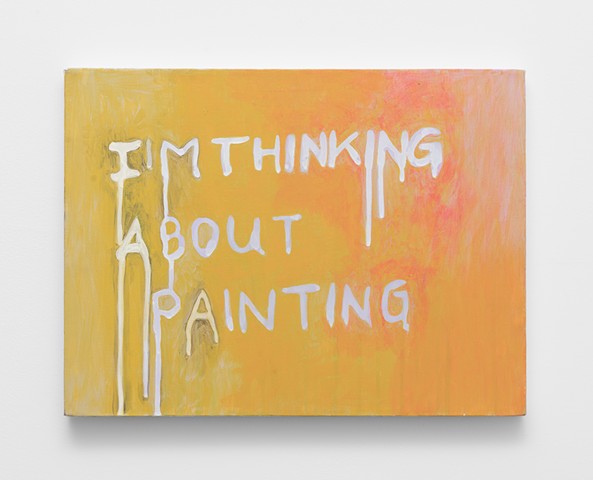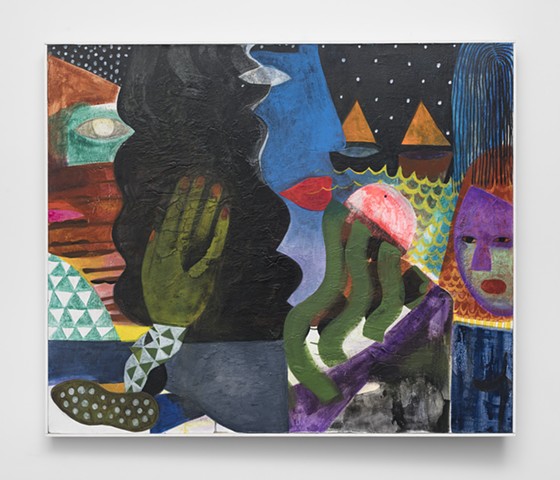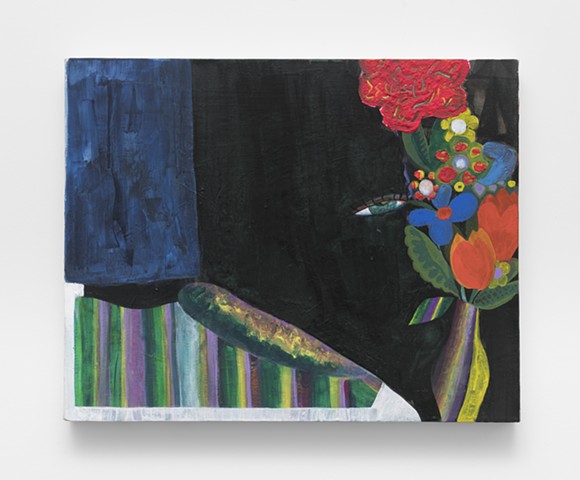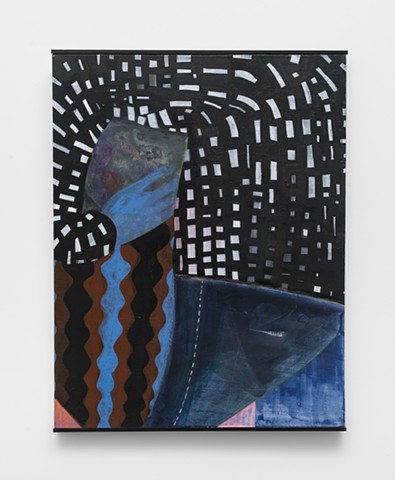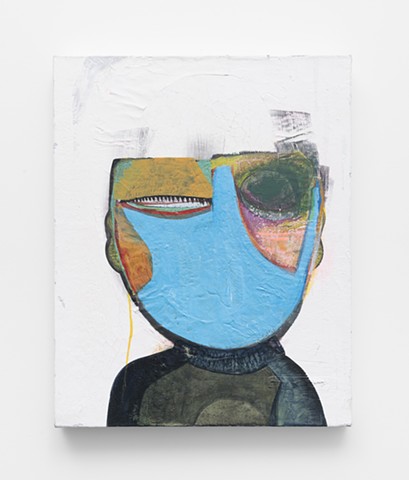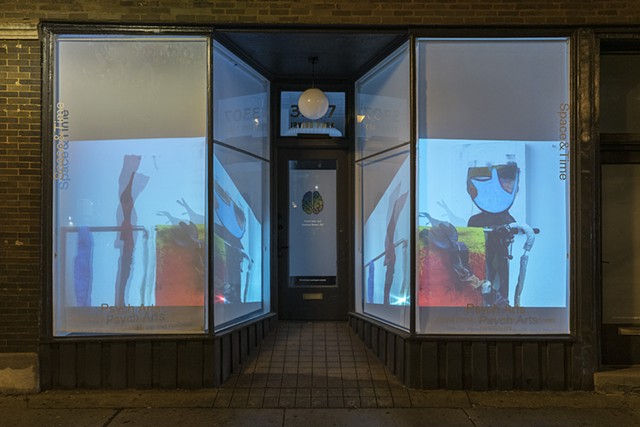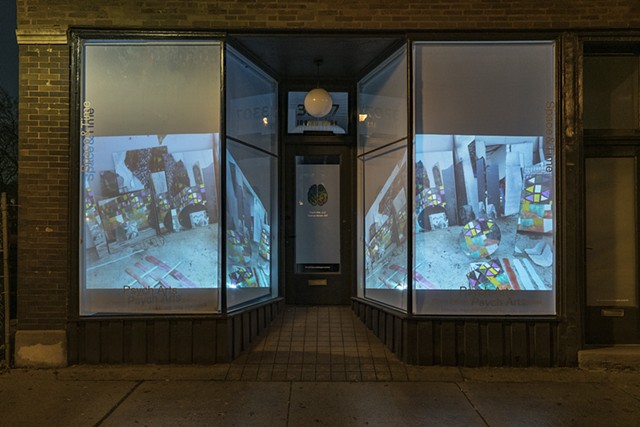I'm Thinking about Painting
I’m Thinking about Painting
This is my first exhibition of paintings. Paintings on canvas. Painting is a loaded medium for me, both in the broader context of art and within the specifics of my family. My mother and grandmother are both painters. As an artist, I needed to find my own space, outside of painting and outside my familial conversation about painting. But I, too, love to paint and so found ways to incorporate it into my work. My final products were not paintings but rather mediations of painting within something greater: a photo or an animation.
All of my studio work is made according to an overarching conceptual modus, my durational performance “I work with what I have.” This performance started in 2012, when I decided to make art with only what was already in my studio and to treat the production of my art as one that adjusts and adapts as materials run out, with nothing brought in to replace them. The studio is a self-depleting system.
As part of this system, I have ten canvases. I make paintings that are part of larger installations. When the piece is done, the paintings are overpainted to take on a new role in a new piece. Over the past nine years, I have painted and overpainted these canvases so many times that they have become lumpy and bumpy.
I still regret overpainting some of these paintings. But at the same time, knowing these paintings were destined for such a short life made painting easy and fun. Less loaded. I developed a language and style in the painting, a lightness. I didn’t think of these canvases as commercial objects or as weighted by any pressure other than performing in the greater piece.
At the end of 2019, I finished a large project and was figuring out what to do next. In moments of indecision, I move toward the thing I have been avoiding; the goal is to walk into whatever wall might be looming ahead and see what happens. What I hit on was painting on canvas. To make paintings that are just paintings, not props—paintings that would live on—and then to show these paintings and to sell them.
So I started to paint. And then I got really into painting. The painting responds to the surfaces formed by the years of overpainting; the paintings’ deep history plays a role in their current state. The resulting work is a little askew—each canvas a visual puzzle, almost abstract, but not. Look closely and you’ll find blue jeans, sneakers, flowers, boats, eyes, complex women not there to please but in active relationship with the viewer. These are paintings that I love and am proud of, that I want you to see, to love, and to buy. But then the pandemic hit, followed by quarantine, and everything stopped. The paintings were done, but nobody could see them.
Until galleries and museums learned to adapt. And soon email invitations to virtual exhibition after virtual exhibition floated in. Most of these shows were sad; the intrusion of technology made the work feel further removed, less real, more a reminder of what we couldn’t experience than an experience of the art itself. I started thinking about the medium of virtual exhibits. I looked at the paintings in my studio with no one to see them and nowhere to go, and I thought about my strange predicament as the artist who was also, in a way, the gallerist: I had to sell the work, to find some way to show it.
The problem is the prompt.
I decided to make a virtual exhibition. But instead of focusing on the paintings alone, I imagined a show that was a piece unto itself—something reflecting on our current situation and how the sudden full stop of business as usual forced us all to look at ourselves in new ways. I also wanted to address dilemmas specific to the art world—those we are confronted with as artists, gallerists, and audiences—and the fluidity of our realities and the roles we inhabit within them. I consider the act of making paintings, conventional paintings, as inextricably linked to questions regarding the value of art and how we relate to the market—to selling, reselling, capital, and investment. To me, paintings feel more tied to capitalist structure than the work I usually make. Unique and irreproducible, they are commodities in a way that a film, for instance, is not.
And so I set up a white box gallery space in my studio. I hung the show. I made two sculptures to represent the artist/gallerist and artist/viewer, who would act as my avatars. Over the course of the first year of the pandemic, I animated the space and the characters. I developed the language and acoustic space for the piece. When I felt moved, I sang into my phone, then took that audio, cut it up, digitally manipulated it, and combined it with the animation. I thought of it as a pandemic Umbrellas of Cherbourg, contemplating the art world in sung dialogue, acted out on a stylized set. In my scenario, it is sometimes hard to know who is whom and what is what. That’s by design; in the art world, we often fill many roles. And here I am the one who is selling this work, I am the one who is looking at this work, I am the one who is creating this work.
The art market is built on a capitalist structure. To be considered successful, an artist must sell and then sell at higher and higher prices. The worth of the work is defined at auction. Wealth becomes the measure. But what sells, why, and for how much? Who can afford it? Where did that money come from? Who is hurt in the process, and are we all complicit? Opportunity has allowed me movement through the art world, from apartment gallery to museum. Commercial and established institutions, I find, often work at odds with the issues addressed by the art on display. I wonder, does financing space for artists who challenge their ethics grant sponsors absolution for the ways they create their wealth? Does political art in this context become a “moral laundry” service? Is it penance for the rich or just a way for us to pay the bills?
I have no answers / I have some answers. I made paintings. I want to sell them. I want them to be loved. I need to pay my bills. The pandemic isn’t over, but galleries are open again. So now I am showing them here. You can come in and be with them, see their lumpy surfaces and inner glow. And because virtual exhibits are here to stay, I’ll be sending out my virtual exhibition video featuring these paintings so you can experience my art at a distance, too. And, at night, when the gallery is closed, you can see the film projected across the entire window front; if you are waiting for the bus right there, you will hear me sing.
—Selina Trepp
